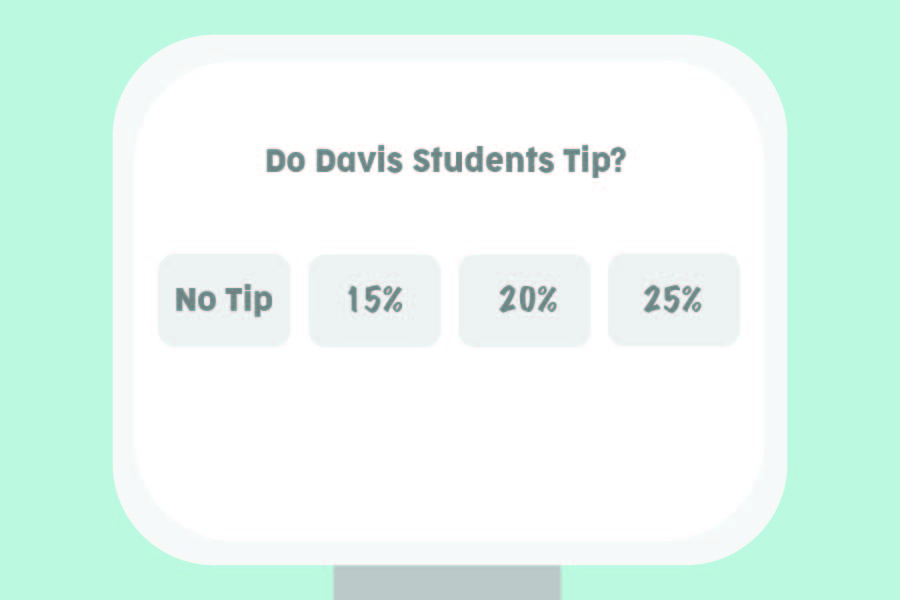
Exploring what tipping looks like in Davis.
Anytime someone gets a service done or orders food from a restaurant, cafe or other food service establishment, they are usually faced with the tipping question. Tipping in general creates a lot of pressure and can be a bit uncomfortable. Some common worries include not having enough money to cover a tip, wondering whether or not the employee providing a service deserves a tip, seeming like a bad person for leaving a low tip and not knowing if a certain service requires tipping.
Nicole Lindenauer, a third-year evolution, ecology and biodiversity major and manager at Burgers and Brew has noticed tipping discrepancies between college-aged and older customers.
“I guess it depends,” Lindenauer said. “Like normally when you get good tips, it’s generally from the older crowd like adults […]. I would say college students generally tip about between 10 to 15 percent and then if they’re like really vibing with you, then like 20 percent.”
Lindenauer also noticed a difference between larger and smaller groups.
“I find, we’ll get groups of like 10 to 15 college students and they usually tip 20 percent, when it’s big groups like that, because they’re a lot more work, you know,” Lindenauer said. “But if it’s just a two top per se, then it usually will be about like 15 percent.”
She has also noticed a difference in how friendly college students are as customers compared to the rest of the Davis community.
“I guess students are less likely to interact with a conversation with me than adults,” Lindenauer said. “So if I’m serving a table it’ll just kind of be the serving part if it’s college students, but then if it’s an older couple, they will just be like, ‘Oh! What’s your major? Like, where are you from?’ and try to like get to know me more, so that’s kind of like I guess a pretty big difference there.”
Paige Ingles, a fourth-year psychology major and a barista at Peet’s Coffee has experienced a different tipping protocol.
“This is the first place I’ve worked at where we get tips,” Ingles said. “I worked at a Peet’s on campus and we weren’t allowed to accept tips because we were through student housing and dining, so it wasn’t allowed […]. Here [downtown] especially we do get tips a lot, because people order their coffee [and] they get their change [so] they’ll just throw it in the [tip] jars because the jars are there. Other places I’ve worked at there [are] no jars,” Ingles said.
Ingles did note that college students are not necessarily the most frequent tippers at Peet’s.
“Not very often [do students tip],” Ingles said. “It’s mostly like, here we have a lot of regulars and they do tend to be working class or more old people, more established people and with like college students, we also don’t pay [with] cash very often and so I just notice that usually every time students come in, they’ll be paying with card anyways, so it’s not like they have anything to tip.”
Courtney Crawford, a server at Crepeville who graduated in 2012 with a degree in biology, has also noticed differences in tipping in Davis.
“I would say they do generally tip,” Crawford said. “But because we are the walk-up counter service style, I think that does sometimes inhibit people from tipping because they’re not sure how it works, so especially if they’ve never been here before, they walk in and they have really no clue if they should order up here [or] sit down at the tables. I think that uncertainty, it kind of makes people not tip, but if people have been here before, I feel like they’re more likely to tip.”
Crawford also commented on how Davis students tip specifically.
“I would say sometimes they do, sometimes they do not,” Crawford said. “Probably, that’s gonna be a hit or miss, usually, I feel like when they’re with their group of friends and let’s say like one person does and there’s like three people, then the next two people behind them will, but not always when they’re by themselves.”
Students also chimed in about their tipping habits.
“I usually do like 15 percent or 20 percent depending on if they were like super nice or something, then I’ll do like 20 percent,” said Adrienne Parker, a first-year cognitive science major.
Sara Frederich, a third-year international agricultural development major, discussed her personal protocol for tipping.
“[At] a restaurant, I’ll normally do like 15 percent and then if I go get coffee, I’ll do like 10 percent,” Frederich said.
Giselle Tavarez, a first-year animal science major explained why she personally tips.
“Just because I feel like people should get extra money for doing their job,” Tavarez said. “[I tip] just because it’s nice and just to let them know like that you appreciate what they’re doing in a way,” Tavarez said.
It seems clear that college students may have many resources, but money is at least somewhat limited. College students do not always tip and do not always tip well, but in general, when acknowledging economic constraints, we are doing okay. It certainly wouldn’t hurt to be more aware when prompted to tip in order to show more consideration for food service workers.
Written by: Ethan Pearson — arts@theaggie.org



